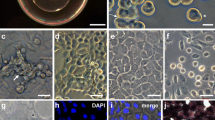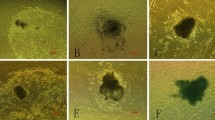Abstract
Fish embryonic stem cells (ESCs) are derived from blastomeres that have been cultured from blastula embryos. The most widely used method for derivation of fish ESCs is the culture of blastomeres that have been isolated from approximately 10 blastula embryos under feeder-free conditions. However, this method leads to intercellular genetic heterogeneity among the cultured cells, which is a major obstacle to the development of stable ESC culture conditions. In this study, to establish ESC lines with intercellular genetic homogeneity at the early stage of culture, we attempted to derive embryonic cell lines from single blastula–derived blastomeres of marine medaka (Oryzias dancena) in a feeder cell culture system. Using basic fibroblast growth factor–expressing feeder cells during primary culture, we successfully established 22 single blastula–derived embryonic cell lines that could be subcultured more than 20 times. In contrast, we were unable to efficiently derive cell lines using wild-type feeder cells and under feeder-free conditions. The established cell lines exhibited ESC-like cell characteristics in terms of alkaline phosphatase activity, pluripotency-related gene expression, and embryoid body formation. The results of this study will contribute to the development of methods for derivation of fish ESCs.



Similar content being viewed by others
References
Alvarez MC, Bejar J, Chen S, Hong Y (2007) Fish ES cells and applications to biotechnology. Mar Biotechnol 9:117–127
Bialkowska AB, Yang VW, Mallipattu SK (2017) Krüppel-like factors in mammalian stem cells and development. Development 144:737–754
Boyer LA, Lee TI, Cole MF, Johnstone SE, Levine SS, Zucker JP, Guenther MG, Kumar RM, Murray HL, Jenner RG, Gifford DK, Melton DA, Jaenisch R, Young RA (2005) Core transcriptional regulatory circuitry in human embryonic stem cells. Cell 122:947–956
Bryja V, Bonilla S, Arenas E (2006) Derivation of mouse embryonic stem cells. Nat Protoc 1:2082–2087
Chambers I, Colby D, Robertson M, Nichols J, Lee S, Tweedie S, Smith A (2003) Functional expression cloning of Nanog, a pluripotency sustaining factor in embryonic stem cells. Cell 113:643–655
Choi JH, Gong SP (2018) Effects of temperatures and basal media on primary culture of the blastomeres derived from the embryos at blastula stage in marine medaka Oryzias Dancena. J Embryo Transfer 33:343–348
Guo G, von Meyenn F, Santos F, Chen Y, Reik W, Bertone P, Smith A, Nichols J (2016) Naive pluripotent stem cells derived directly from isolated cells of the human inner cell mass. Stem Cell Reports 6:437–446
Eiselleova L, Peterkova I, Neradil J, Slaninova I, Hampl A, Dvorak P (2008) Comparative study of mouse and human feeder cells for human embryonic stem cells. Int J Dev Biol 52:353–363
Elling U, Woods M, Forment JV, Fu B, Yang F, Ng BL, Vicente JR, Adams DJ, Doe B, Jackson SP, Penninger JM, Balmus G (2019) Derivation and maintenance of mouse haploid embryonic stem cells. Nat Protoc 14:1991–2014
Fan Z, Liu L, Huang X, Zhao Y, Zhou L, Wang D, Wei J (2017) Establishment and growth responses of Nile tilapia embryonic stem-like cell lines under feeder-free condition. Develop Growth Differ 59:83–93
Freshney RI (2010) Culture of animal cells: a manual of basic technique and specialized applications. Wiley-Liss, New York
Gong SP, Kim H, Lee EJ, Lee ST, Moon S, Lee HJ, Lim JM (2009) Change in gene expression of mouse embryonic stem cells derived from parthenogenetic activation. Hum Reprod 24:805–814
Greber B, Lehrach H, Adjaye J (2007) Fibroblast growth factor 2 modulates transforming growth factor beta signaling in mouse embryonic fibroblasts and human ESCs (hESCs) to support hESC self-renewal. Stem Cells 25:455–464
Ho SY, Goh CW, Gan JY, Lee YS, Lam MK, Hong N, Hong Y, Chan WK, Shu AC (2014) Derivation and long-term culture of an embryonic stem cell-like line from zebrafish blastomeres under feeder-free condition. Zebrafish 11:407–420
Hong Y, Schartl M (2006) Isolation and differentiation of medaka embryonic stem cells. Methods Mol Biol 329:3–16
Hu B, Lefort K, Qiu W, Nguyen BC, Rajaram RD, Castillo E, He F, Chen Y, Angel P, Brisken C, Dotto GP (2010) Control of hair follicle cell fate by underlying mesenchyme through a CSL-Wnt5a-FoxN1 regulatory axis. Genes Dev 24:1519–1532
Kim YY, Oh SK, Choi YM (2007) Feeder cells for culture of human embryonic stem cells. Korean J Reprod Med 34:219–277
Kueh J, Richards M, Ng SW, Chan WK, Bongso A (2006) The search for factors in human feeders that support the derivation and propagation of human embryonic stem cells: preliminary studies using transcriptome profiling by serial analysis of gene expression. Fertil Steril 85:1843–1846
Laslett AL, Filipczyk AA, Pera MF (2003) Characterization and culture of human embryonic stem cells. Trends Cardiovasc Med 13:295–301
Lee D, Kim MS, Nam YK, Kim DS, Gong SP (2013) Establishment and characterization of permanent cell lines from Oryzias dancena embryos. Fish Aquat Sci 16:177–185
Lee DW, Ryu JH, Lee ST, Nam YK, Kim DS, Gong SP (2015) Identification of embryonic stem cell activities in an embryonic cell line derived from marine medaka (Oryzias dancena). Fish Physiol Biochem 41:1569–1576
Levenstein ME, Ludwig TE, Xu RH, Llanas RA, VanDenHeuvel-Kramer K, Manning D, Thomson JA (2006) Basic fibroblast growth factor support of human embryonic stem cell self-renewal. Stem Cells 24:568–574
Llames S, García-Pérez E, Meana Á, Larcher F, Río M (2015) Feeder layer cell actions and applications. Tissue Eng Part B Rev 21:345–353
Namba M, Fukushima F, Kimoto T (1982) Effects of feeder layers made of human, mouse, hamster, and rat cells on the cloning efficiency of transformed human cells. In Vitro 18:469–475
Nishikawa S, Jakt LM, Era T (2007) Embryonic stem-cell culture as a tool for developmental cell biology. Nat Rev Mol Cell Biol 8:502–507
Richards M, Fong CY, Chan WK, Wong PC, Bongso A (2002) Human feeders support prolonged undifferentiated growth of human inner cell masses and embryonic stem cells. Nat Biotechnol 20:933–936
Roy A, Krzykwa E, Lemieux R, Néron S (2001) Increased efficiency of gamma-irradiated versus mitomycin C-treated feeder cells for the expansion of normal human cells in long-term cultures. J Hematother Stem Cell Res 10:873–880
Ryu JH, Gong SP (2017) Effects of the developmental stage of extract donor embryos on the culture of marine medaka Oryzias dancena embryonic stem cell-like cells. Korean J Fish Aquat Sci 50:160–168
Ryu JH, Gong SP (2020) Effects of feeder cells on the primary culture of ovarian cell populations from adult Japanese medaka (Oryzias latipes). J Anim Reprod Biotechnol 35:65–72
Scheper W, Copray S (2009) The molecular mechanism of induced pluripotency: a two-stage switch. Stem Cell Rev Rep 5:204–223
Schwartz PH, Brick DJ, Nethercott HE, Stover AE (2011) Traditional human embryonic stem cell culture. In: Schwartz P., Wesselschmidt R (eds) Human pluripotent stem cells. Methods in Molecular Biology (Methods and Protocols), vol 767. Humana Press.
Stojkovic P, Lako M, Stewart R, Przyborski S, Armstrong L, Evans J, Murdoch A, Strachan T, Stojkovic M (2005) An autogeneic feeder cell system that efficiently supports growth of undifferentiated human embryonic stem cells. Stem Cells 23:306–314
Song HY, Nam YK, Bang IC, Kim DS (2009) Embryogenesis and early ontogenesis of a marine medaka, Oryzias dancena. Kor J Ichthyol 21:227–238
Wang ZX, The CHL, Chan CMY, Chu C, Rossbach M, Kunarso G, Allapitchay TB, Wong KY, Stanton LW (2008) The transcription factor Zfp281 controls embryonic stem cell pluripotency by direct activation and repression of target genes. Stem Cells 26:2791–2799
Yi M, Hong N, Hong Y (2009) Generation of medaka fish haploid embryonic stem cells. Science 326:430–433
Yi M, Hong N, Hong Y (2010) Derivation and characterization of haploid embryonic stem cell cultures in medaka fish. Nat Protoc 5:1418–1430
Zhang J, Tam WL, Tong GQ, Wu Q, Chan HY, Soh BS, Lou Y, Yang J, Ma Y, Chai L, Ng HH, Lufkin T, Robson P, Lim B (2006) Sall4 modulates embryonic stem cell pluripotency and early embryonic development by the transcriptional regulation of Pou5f1. Nat Cell Biol 8:1114–1123
Acknowledgements
This work was supported by a research grant of Pukyong National University (2021).
Author information
Authors and Affiliations
Corresponding author
Rights and permissions
Springer Nature or its licensor holds exclusive rights to this article under a publishing agreement with the author(s) or other rightsholder(s); author self-archiving of the accepted manuscript version of this article is solely governed by the terms of such publishing agreement and applicable law.
About this article
Cite this article
Son, M.J., Gong, S.P. Feeder cell–dependent primary culture of single blastula–derived embryonic cell lines from marine medaka (Oryzias dancena). In Vitro Cell.Dev.Biol.-Animal 58, 840–850 (2022). https://doi.org/10.1007/s11626-022-00727-1
Received:
Accepted:
Published:
Issue Date:
DOI: https://doi.org/10.1007/s11626-022-00727-1




